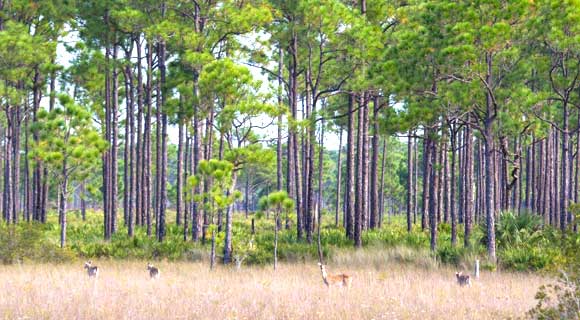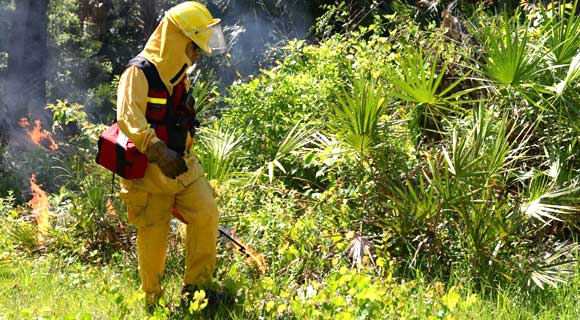Florida’s Wildlife Management Area System Turns 75, FWC Tasked With Managing Property
By Space Coast Daily // April 4, 2017
WMA Nearly 6 Million Acres Strong

BREVARD COUNTY, FLORIDA – Back in 1941, Florida was a much different state with a population of less than 2 million people. However, growth and development soon threatened the landscape and habitat for the state’s native wildlife.
Then the Florida Legislature allowed the state to accept federal funds to be used for conservation land acquisition.
The first purchase made by the state 75 years ago was a 19,200-acre tract of land north of Fort Myers that is part of the area now known as the Fred C. Babcock/Cecil M. Webb Wildlife Management Area.
The Florida Game and Fresh Water Fish Commission – now the Florida Fish and Wildlife Conservation Commission (FWC) – was tasked with managing the new property, and so began Florida’s WMA system.
Today, Florida is blessed to have one of the largest WMA systems in the country with nearly 6 million acres. These public lands play a critical role in helping the FWC accomplish its mission of managing the state’s fish and wildlife resources for their long-term well-being and the benefit of people.
Carrying out this mission requires forward thinking, expertise, creativity and balancing needs, as about 1,000 people move into Florida each and every day with the current population topping 20 million residents.
As Florida’s human population grows, so do the pressures put on our native wildlife and remaining natural resources. These areas conserve the natural ecosystems that support our game animals and imperiled species. The FWC works diligently to balance the needs of Florida’s wildlife with the state’s growing population.

Partners for Public Hunting
WMAs are managed for conservation and recreation, and offer diverse and exciting public hunting opportunities. It takes expertise in proper habitat management, and partnerships with other land managers to make this happen.
The FWC is the lead manager or landowner of about 1.4 million acres of these public lands. The remaining 4.5 million acres of the WMA system are open for public hunting thanks to partners and cooperators including the Florida Forest Service, Northwest Florida Water Management District, Suwannee River Water Management District, St. Johns River Water Management District, Southwest Florida Water Management District, South Florida Water Management District, Florida Armory Board, Florida Department of Environmental Protection, Florida Department of Corrections, U.S. Forest Service, U.S. Department of Defense, National Park Service, Alachua County, Collier County, Columbia County, Levy County, Orange County, Volusia County, Martin County, U.S. Army Corps of Engineers, U.S. Fish and Wildlife Service, Hancock Timber Resource Group, Weyerhaeuser Company, PotashCorp, city of Jacksonville, The Nature Conservancy, The Sam Shine Foundation, PRIDE Enterprises and the Miccosukee Tribe of Indians of Florida.
Wildlife Management Techniques
The quality habitat that is found on these WMAs doesn’t just happen on its own. It takes scientific know-how and never-ending, labor-intensive work by teams of biologists and technicians employing a variety of proven wildlife management strategies to manipulate and best manage these lands for native species.
Fire is important to the long-term health of many of Florida’s forest ecosystems, so periodic controlled burns are done that release nutrients into the soil, stimulate seeds to sprout and help control invasive plants and hardwood undergrowth. By doing this, native wildflowers and grasses can grow, which provide food, cover and better breeding habitat for a wide variety of species.
Timber thinning is another management practice that is used. It does not benefit wildlife to have rows of planted pines placed so closely together that the canopy becomes completely closed off. By removing some trees and allowing sunlight to reach the forest floor, native grasses are able to grow, which provide food and cover for wildlife.
Roller chopping is used to remove dense palmetto thickets that cover so much of the Florida landscape. A roller chopper is a machine with a large steel cylindrical drum and blades pulled by a bulldozer or tractor. This management practice also is used when prescribed fire hasn’t been done in a while, and a dense undergrowth of shrubs and smaller trees has choked out the natural habitat, making it less usable for wildlife.
Restoration sometimes is required in order to convert areas from their previous land uses back to their natural ecosystems. And in some cases, restoring means removing or treating with environmentally-safe chemicals invasive nonnative plant species, such as Brazilian pepper and Japanese climbing fern. After unwanted vegetation is removed from an area, the groundcover can be restored to its original ecosystem by planting native seeds and seedlings, such as longleaf pine and cypress trees.

A Win For Wildlife – a Win Ror Floridians!
Thanks to the hard work that is performed daily by the many wildlife professionals employed by the FWC and its cooperating land managers, we all can enjoy premier places to hunt with our friends and family, view wildlife in its natural setting and escape from the hustle and bustle of everyday life.
If the founders of Florida’s WMA system were alive today, they would most certainly be proud of what they started. Due to their wisdom and foresight, millions of Floridians and visitors get to experience these wild lands and the native wildlife that call it home, and will continue to be able to do so well into the future.
CLICK HERE FOR BREVARD COUNTY NEWS















